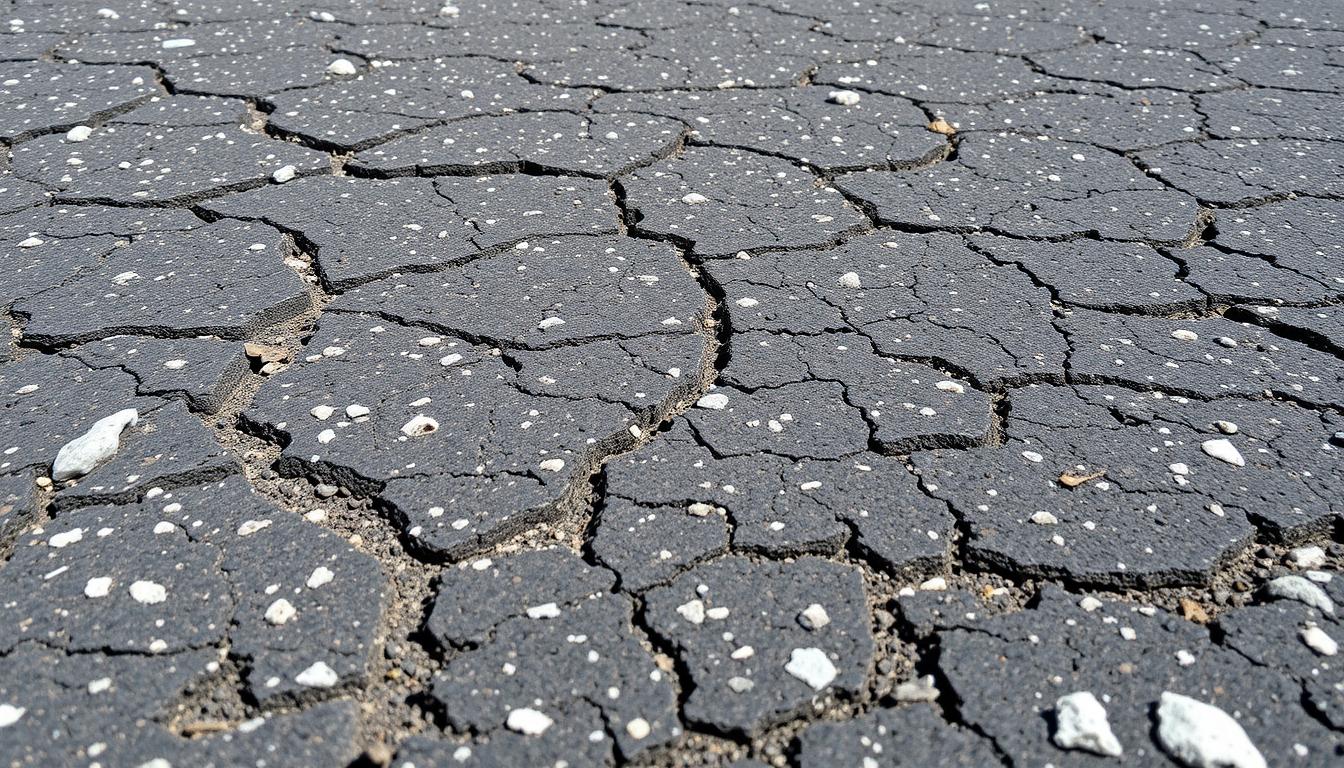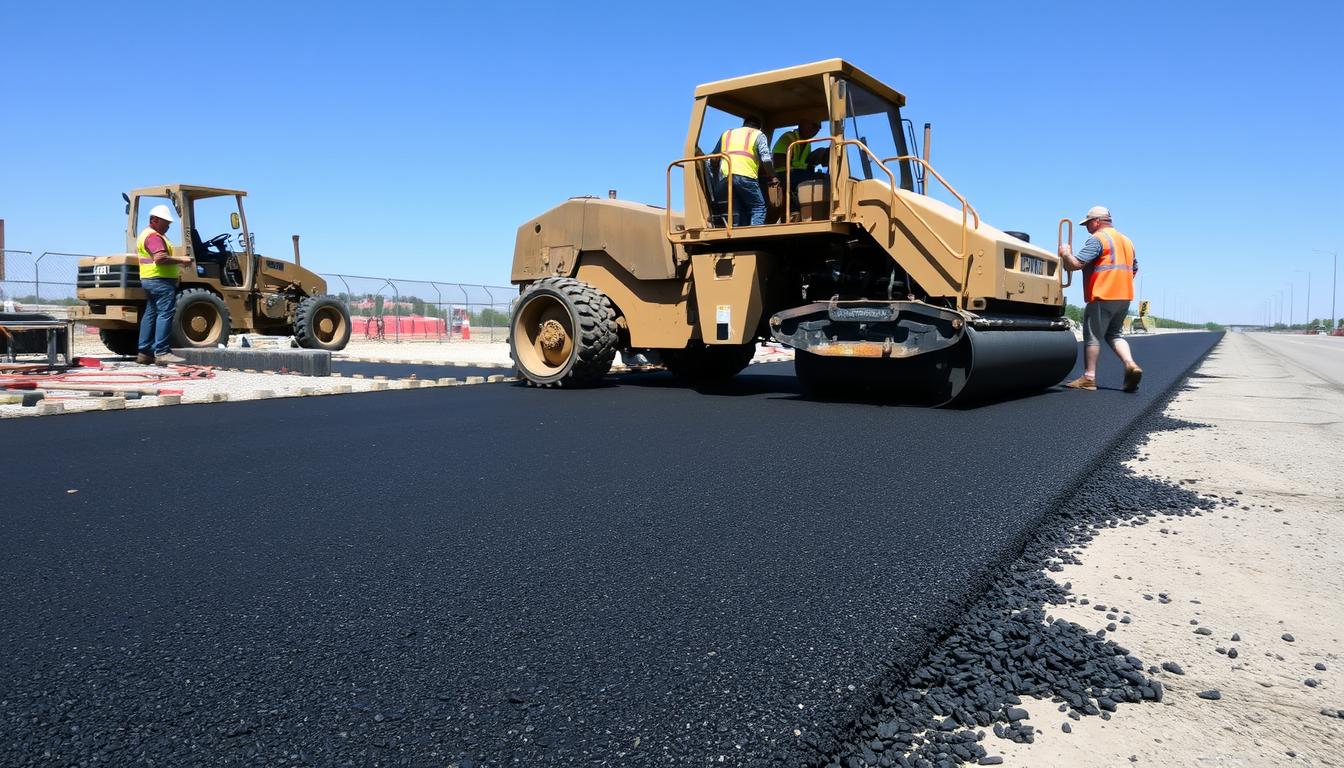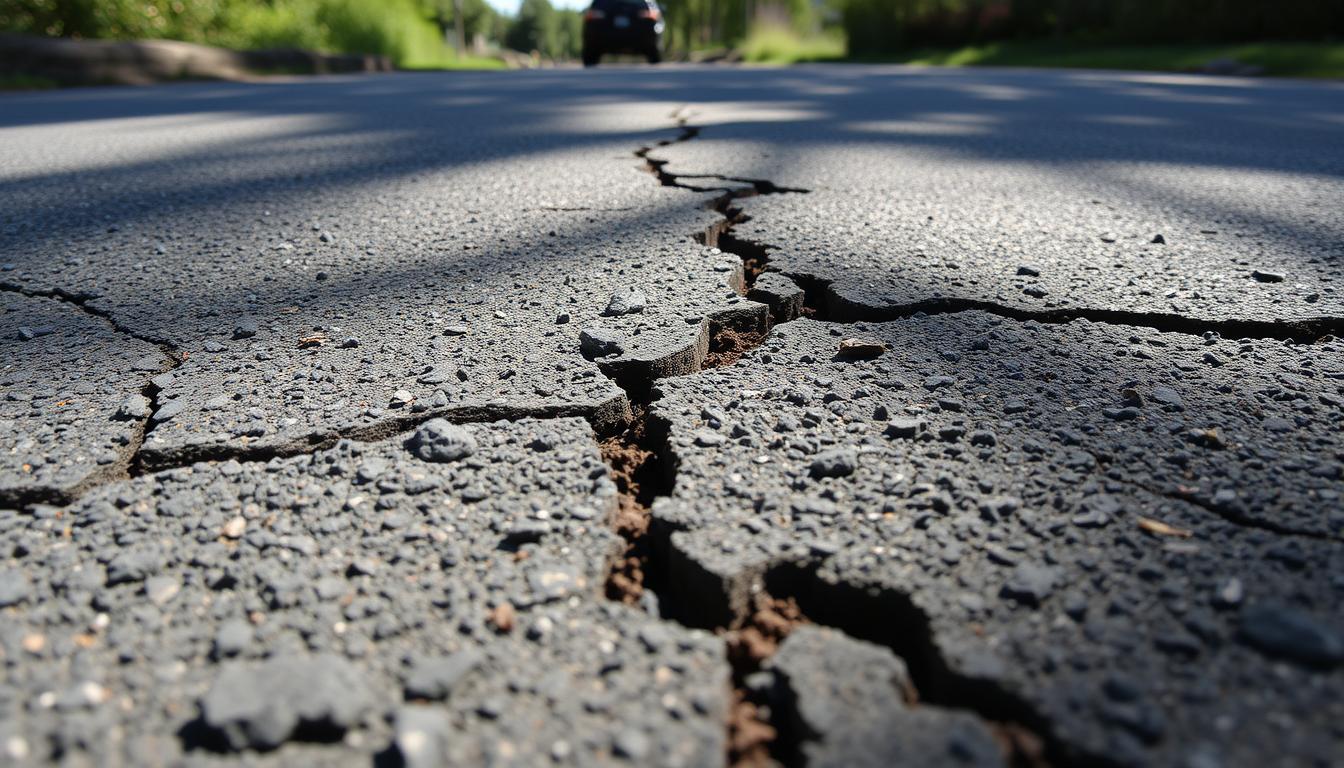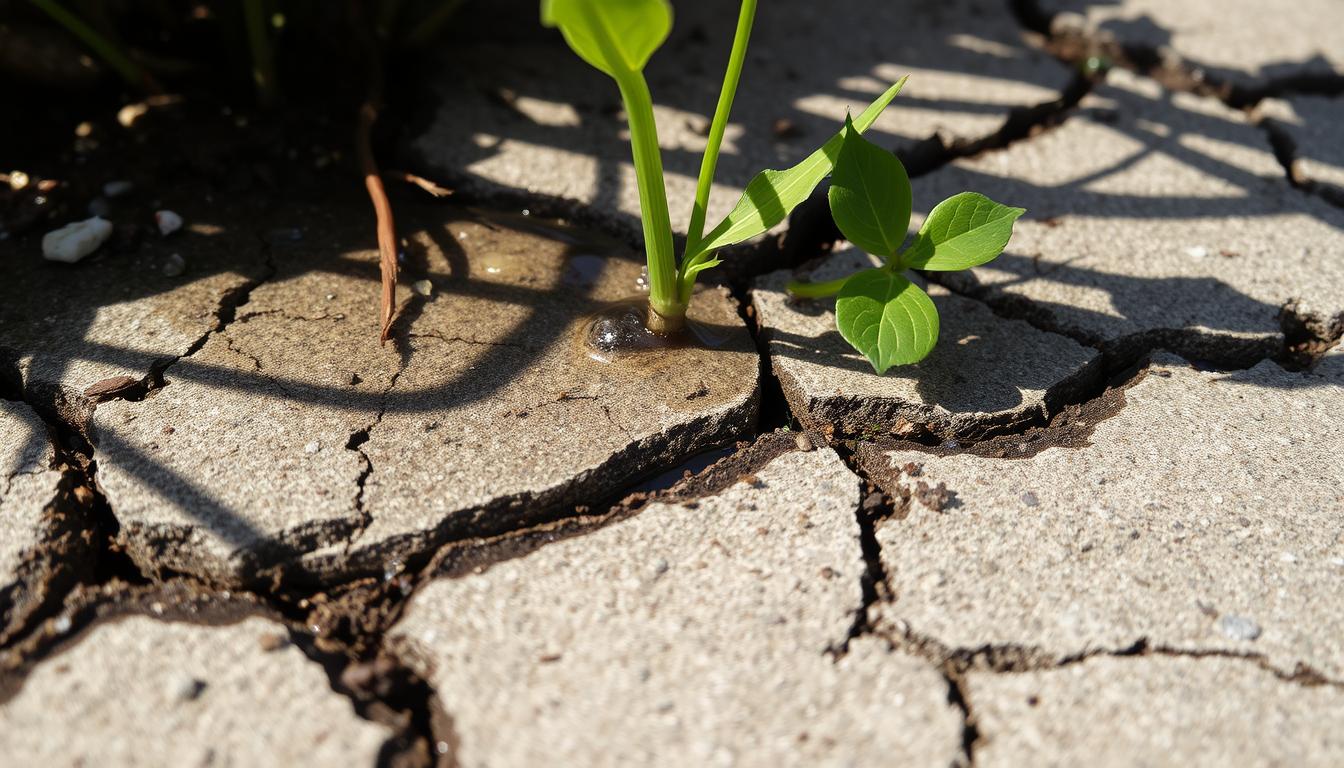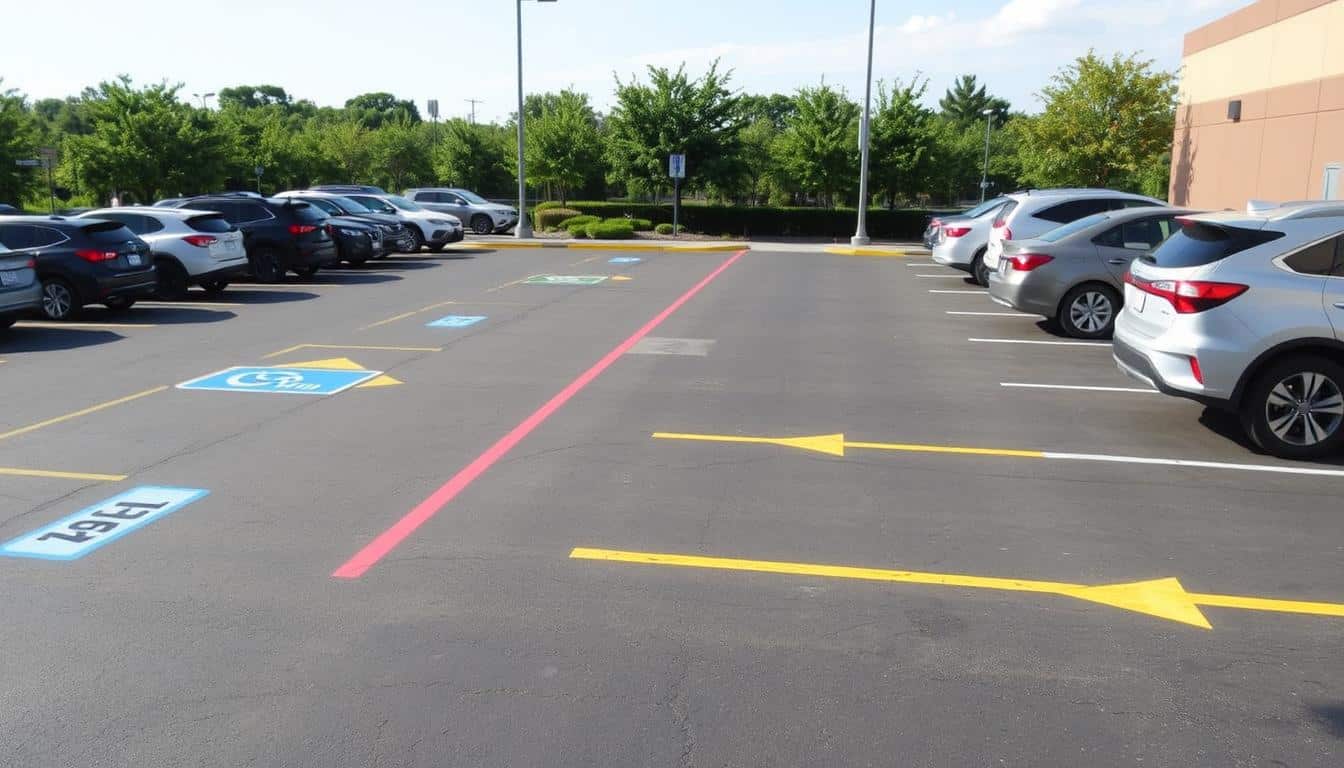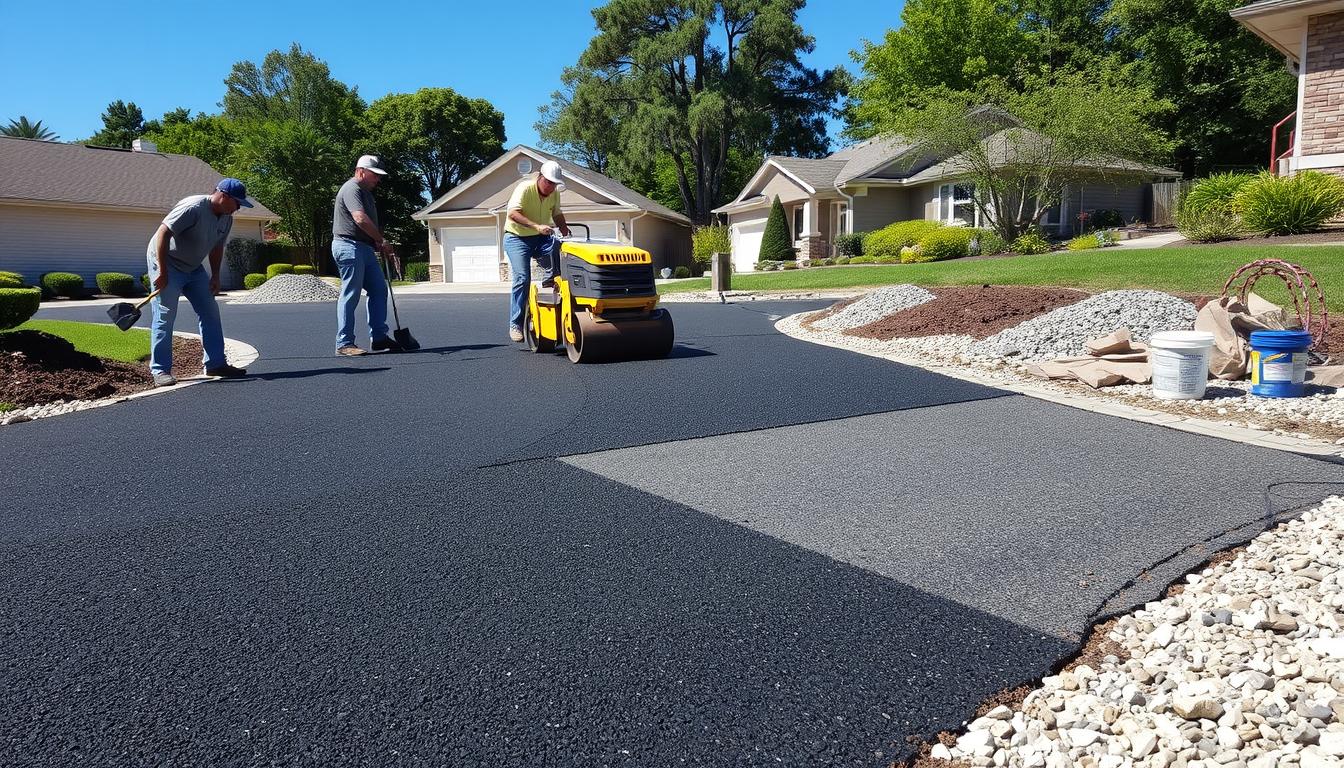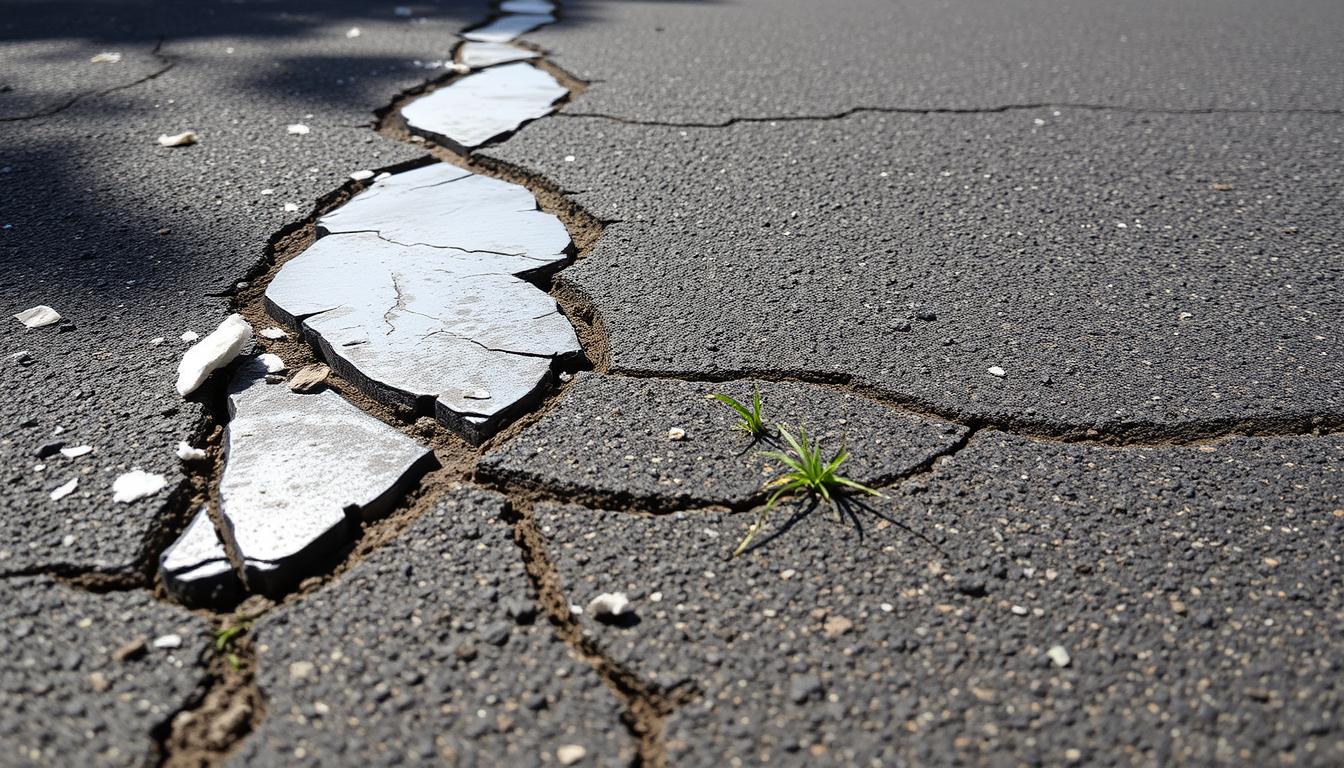Why do asphalt surfaces crack and deteriorate over time? Many think asphalt is very durable. But, weather and heavy traffic can damage it. Knowing what causes asphalt cracks is key for fixing them and keeping them in good shape.
In this article, we’ll explore the types of asphalt cracks and what they mean. We’ll also look at the causes and the best ways to fix them. We’ll focus on the expertise of HT Paving and Seal Coating Services in the Bay Area, California.
Key Takeaways
- Moisture-related damage constitutes about 40% of asphalt pavement failures.
- Alligator cracks are often a result of heavy vehicle traffic, especially in parking lots.
- Transverse cracks are common in colder climates, during freeze-thaw cycles.
- Regular maintenance can greatly reduce serious asphalt cracks.
- Resurfacing can extend asphalt pavement life and cut costs.
- Proper installation techniques lower the risk of cracking.
Understanding Asphalt Cracks
Asphalt cracking comes in many forms, each hinting at deeper problems. Knowing the common types of cracks is key to keeping your pavement in good shape. By understanding what causes these cracks, you can fix them early, saving your pavement a lot of trouble.
Common Types of Asphalt Cracks
Alligator cracks are a common sight, showing heavy traffic or poor base. Transverse and longitudinal cracks happen due to temperature changes and asphalt aging. Block cracking, seen in older surfaces, is often caused by water that weakens the asphalt.
What Do Asphalt Cracks Indicate?
Every crack type tells a story. Alligator cracks mean too much stress, while block cracks point to moisture and age problems. Catching these signs early can stop bigger issues and save you from expensive fixes.
How Climate Influences Cracking
Weather and asphalt cracks are closely related. Temperature changes cause asphalt to expand and contract, leading to cracks. Moisture makes things worse, causing block cracking. Keeping up with maintenance and sealing cracks can help your pavement last longer, despite the weather.
Factors Contributing to Asphalt Cracking
Understanding why asphalt cracks is essential for road maintenance. Weather changes, vehicle weight, and poor drainage are main causes. Each factor impacts asphalt durability.
Temperature Fluctuations
Temperature changes harm asphalt. Heat and cold cause it to expand and shrink. This leads to cracks, often worsened by poor installation.
In areas with extreme temperatures, like the Midwest, damage accelerates.
Weight and Pressure from Vehicles
Vehicle weight damages asphalt. Heavy traffic and large trucks stress roads, causing cracks. Regular inspections help prevent these issues.
Checking roads and parking lots often is critical.
Moisture Issues and Drainage Problems
Excessive water and poor drainage harm asphalt. Water in cracks damages the soil beneath, enlarging cracks. Proper drainage and upkeep strengthen asphalt.
The Importance of Proper Installation
Proper installation is critical for asphalt longevity. Using high-quality materials and techniques minimizes cracks. Working with a professional ensures compliance with standards.
Quality of Materials
Asphalt strength depends on material quality. High-grade asphalt and additives extend its life. Better materials reduce cracking and enhance safety.
Techniques for Minimizing Cracks
Proper installation techniques are vital. Ensuring adequate thickness and compaction is essential. Adding drainage features is also critical for durability.
The Role of a Professional Paving Contractor
Choosing a professional paving contractor is essential. They use the best materials and techniques. This ensures a durable, long-lasting surface.
Preventative Measures for Asphalt Longevity
Effective preventative measures extend asphalt life. Early action reduces cracks, saving money and ensuring safety. Regular upkeep, sealcoating, and early crack filling are key.
Regular Maintenance Practices
Regular inspections are critical for early problem detection. Annual checks catch small cracks that let water in. Fixing these issues quickly prevents bigger problems. Keeping the surface clean also aids in water drainage.
Importance of Sealcoating
Sealcoating protects asphalt from damage. It shields against UV rays, moisture, and decay. Studies show sealcoating every 2-3 years can significantly extend asphalt life. It prevents potholes and other damage.
Filling Cracks Early
Fixing cracks early is vital. Cracks under an inch wide can be fixed if caught early. This prevents water damage and extends asphalt life by 5 to 10 years, saving on repairs.
Signs It’s Time for Repairs
Regularly monitoring asphalt pavements is essential. Spotting early signs of damage prevents major issues. Regular checks help owners know when to act.
Evaluating Crack Severity
Checking cracks is important. Assess their width, depth, and patterns. Small cracks might need sealing, but big ones might require a new layer.
Acting fast can save money and prevent worse damage.
When to Consider Resurfacing
Resurfacing is needed for deep and widespread cracks. Signs like big cracks or many potholes indicate it’s time. This step fixes current issues and extends pavement life.
Identifying Surface Damage
Spotting damage early is vital. Look for potholes, alligator cracks, or water spots. Fixing these quickly stops more damage and saves money. For more on asphalt care, see asphalt crack filling services.
Overview of Repair Methods
Knowing how to fix asphalt cracks is important. Each method is for a specific type and size of damage. This ensures repairs last and are effective.
Crack Filling vs. Sealcoating
Crack filling is a quick fix for small cracks, sealing gaps up to .25 inches wide. Sealcoating, on the other hand, offers a protective layer. It helps extend the life of the asphalt by addressing bigger issues and fighting off the elements. Regular sealcoating is critical, more so in areas with big temperature changes.
Hot and Cold Patch Techniques
For serious asphalt damage, hot and cold patch methods are used. Cold patch asphalt is good for DIY fixes in cooler weather. It’s easy to apply. Hot patches need a pro and special tools, but they work well for big damage areas. It’s important for hot patches to be at least 50% thicker than the original layer for best results.
Resurfacing Options
Resurfacing adds a new layer over the old, making it look and feel better. It’s great for fixing deep wear and tear. Techniques like microsurfacing are cost-effective and seal the pavement. Using these methods and regular maintenance can make your asphalt last longer.
Choosing the Right Contractor
Finding the right contractor is key to a successful asphalt repair and maintenance project. A skilled contractor ensures the work is up to standard and lasts longer. Look for contractor certifications when choosing a contractor. These show they follow best practices and offer quality services.
Importance of Certifications
Contractor certifications show a contractor’s dedication to being the best. They often take part in training to learn new techniques. This means they can do a better job, making sure your investment lasts.
Customer Reviews and Testimonies
Customer reviews are very important. They help you see if a contractor is reliable and does good work. Positive feedback means the contractor is trusted and does a great job. This helps you choose the right contractor.
Services Offered by HT Paving and Seal Coating Services
HT Paving and Seal Coating Services is a top choice in the asphalt industry. They offer a wide range of asphalt services Bay Area. They focus on what customers need and do it well, from small fixes to big projects.
The Repair Process Explained
Starting an asphalt repair involves checking the damage first. We look at the cracks and how they affect the surface. This helps us choose the best way to fix it for good.
Analyzing the Damage
Cracks like alligator and block cracking need a close look. Knowing why they happened helps us pick the right fix. It could be weather, traffic, or poor construction.
Steps in the Repair Process
The repair steps include cleaning, applying materials, and sealing. For example, fixing edge cracks might mean better drainage. Fatigue cracks might need more work. Each step is important for a good fix.
Timeline for Repairs
The time needed for repairs depends on the damage. A good contractor will give a clear plan after checking the asphalt. Planning well helps fix the problem fast and keeps the pavement looking good.
Cost Factors for Asphalt Repairs
Knowing the costs of asphalt repairs is key for homeowners. The average cost is about $1,000, with prices between $500 and $2,500. Costs vary based on square footage or the repair type needed.
A homeowner in Minnesota paid around $1,500 for a cracked driveway fix. This shows how costs can differ greatly.
Understanding Pricing Models
Exploring different pricing models is smart for budgeting asphalt repairs. For example, fixing a pothole costs $100 to $150 per hole. Sealing cracks costs $0.35 to $1.00 per foot.
Resurfacing a driveway costs $1.50 to $2.50 per square foot. Knowing these prices helps make better choices.
Budgeting for Repairs
Effective budgeting is about planning for today and tomorrow. Regular maintenance can prevent costly repairs. For example, a DIY project in Texas fixed a driveway for about $200.
Regular inspections can catch small issues before they become big problems. This approach saves money over time.
Long-term Savings from Proper Maintenance
Good maintenance can extend the life of your asphalt and save money. According to the National Association of Realtors, well-kept asphalt can last up to 20 years. Ignoring repairs can increase vehicle costs by up to 10%.
By focusing on upkeep, homeowners can avoid these extra costs. Regular care is key to saving money.
Conclusion
Getting professional help for your asphalt is essential for its upkeep. Homeowners and property managers should spot cracks early and act quickly. This approach avoids expensive repairs later on. Working with experts ensures your asphalt lasts a long time.
Importance of Professional Help
HT Paving and Seal Coating Services can help with asphalt issues. They handle problems caused by weather and water. Using top-notch materials and methods, they extend your asphalt’s life and prevent major damage.
Recap of Crack Prevention and Repair Services
This article highlighted the importance of maintenance. It discussed how to fix cracks and when to act fast. By following these steps, you can save money on repairs in the future. Contact asphalt experts for custom solutions to keep your pavement looking great.
Contact HT Paving and Seal Coating Services for Assistance
Need help in the Bay Area? Call HT Paving at (415) 774-6424. They are experts in fixing and maintaining asphalt. They can help guide you through the process.


